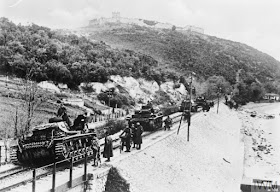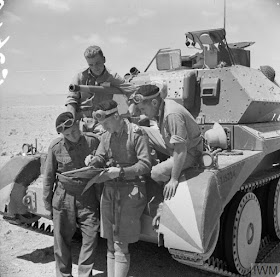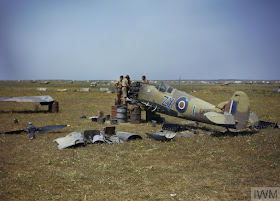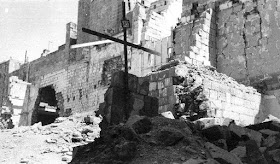Wednesday 30 April 1941
 |
| "German Panzer III tanks advance along a railway line in pursuit of retreating British troops in Greece between 25 and 30 April 1941." © IWM (HU 39517) |
 |
| Some of the last men taken off from Kalamata on 30 April 1941 by HMS Kimberley, taken on 1 May 1941 (Syd Grant Collection). |
The Germans quickly set up a puppet government in Greece. It is led by Georgios Tsolakoglou. They also set up a government in Serbia, known as the Commissioner Government, under Milan Acimovic.
The Germans and Italians quickly occupy the islands of the Aegean abandoned by the British. The Italians send their 2nd Paratroop Battalion to take Zante, Cephalonia and San Mauro, taking 250 Greeks as prisoners, while a black shirt (fascist) division lands on Corfu. These islands will change hands several times during the conflict. The Germans also seize numerous ships in Greece, including 190-ton Panamanian freighter Ines.
The German press announces that Crete is the next objective. Churchill, noting this in a memo to General Ismay, comments that, "Although our evidence points the other way, we must not exclude the possibility that Crete is a blind, and Syria or Cyprus the quarry." This is a great example of how openly telling the plain truth about future military strategy can be an effective way to create doubt in an opponent. Meanwhile, New Zealand General Bernard Freyberg VC is confirmed as the Allied commander in Crete. He commands 29,000 Anzac forces and 9000 Greek troops. General Wavell, Middle East Commander, flies in and briefs Freyberg on Ultra decrypts citing Crete as the next target of German paratroopers (though Freyberg is not told the source).
Iraq War: The standoff continues in Iraq, with Iraqi ground forces threatening the RAF Habbaniya airfield and the RAF planes based there launching strikes against them (authorized by Churchill himself). The Iraqi government orders the military to deploy 28 cannons on the plateau south of the airfield overlooking the airfield and sends 6000 men on a "training mission" there to cover this operation.
The British have 2000 troops in the airfield and 9000 civilians there as well. Additional troops are being airlifted from RAF Shaibah to Habbaniya by the RAF on a piecemeal basis, with civilians being taken out on the return flights. The Iraqis have told the British to cease all flights, but they continue.
European Air Operations: RAF Bomber Command continues its attacks on Channel shipping, focusing today along the Dutch coast. Three Blenheims of No. 2 Group spot a tanker escorted by flak ships and patrolling Bf 110s and the flak shoots down one RAF plane. After dark, Bomber Command sends a major raid (81 bombers) to Kiel and a smaller, diversionary one to Berlin.
The Luftwaffe bombs Cardiff before dawn, causing great damage with land mines.
A Wellington bomber on a training flight crash-lands in St. Andrews Park at Somerville Road in Bristol, killing three crew, after hitting anti-aircraft cables dangling from a barrage balloon. Pilot Lawrence Hugh Houghton survives. The incident is kept out of the newspapers for morale purposes. The incident will be kept secret until 2009 when a memorial service is held, attended by Houghton.
East African Campaign: In Abyssinia, the Indian 9th Infantry Brigade launches small attacks against Italians at Amba Alagi.
Indian 1548 ton patrol vessel Parvati (Lt. HMS Choudri, RIN) hits a mine and sinks at the confluence of the Gulf of Aden and the Red Sea. There are 16 deaths, 14 wounded, and 21 survivors overall.
 |
| U-576, launched on 30 April 1941. It will be sunk off the coast of North Carolina, about 30 miles from Cape Hatteras, on 15 July 1942. Its remains will be rediscovered in 2014. |
Troop transport SS Nerissa (5583 tons) is approaching the British Isles when U-552 (K.Kapt. Erich Topp), on her second patrol out of St. Nazaire, torpedoes and sinks her with three torpedoes at 23:30 about 320 km west of Liverpool. The ship quickly breaks in two, preventing the lifeboats from launching. Fortunately, the radio operator has just enough time to send a Mayday signal with his ship position. There are 84 survivors, picked up by HMS Veteran early the next morning. The Nerissa becomes the only transport carrying Canadian troops to be lost during World War II. This sinking is often cited as occurring on 1 May since it took place around midnight.
German river patrol boat CF-1 is lost today of unknown causes.
The Luftwaffe attacks and sinks tug HMS Peuplier off Plymouth.
The Luftwaffe attacks Westgarth and damages the Royal Navy sloop HMS Erne. It will not be repaired until 21 June 1942.
Royal Navy patrol vessel HMS Loch Oskaig captures the Vichy French freighter Cap Cantin a couple dozen miles off Cape Espichel. The ship is taken to Gibraltar.
German raider Thor arrives in Hamburg, having completed a cruise in which it sank 11 ships totaling 83,000 tons.
Convoy OB 317 departs Liverpool, Convoy SA-1 forms at sea and departs, Convoy HX 124 departs from Halifax.
The Royal Navy commissions frigates HMS Barle and Mourne and corvette Celandine.
The US Navy lays down future destroyers USS Chevalier and Strong.
U-501 (Korvettenkapitän Hugo Förster) is commissioned in Hamburg, and U-453, U-454, U-575, and U-576 are launched.
During the month of April 1941, Axis sinkings spike, largely due to increased success by the long-range Luftwaffe group previously authorized by Adolf Hitler. There are 88 Allied ships sunk with 381,289 tons in Atlantic, 107 Allied ships with 306,512 tons sunk elsewhere (primarily the Mediterranean, where 32 Axis ships with 152,129 tons are sunk. Overall, total Allied shipping losses rise from 474,879 tons in March to 616,469 tons in April (figures will not match up because they come from different sources and calculating such totals is more of an art than a science - even seemingly exact figures are best taken as crude approximations).
The Kriegsmarine loses two U-boats sunk in the Atlantic, Arctic or Baltic. There are 32 serviceable U-boats in Atlantic, a continuing increase over those available at the start of the war. The Allied shipping losses will decline from here until the peak months of 1942, though, because Admiral Doenitz' U-boat fleet has lost some of its best commanders recently.
 |
| "The crew of an A13 Cruiser tank Mk IV studying a map whilst on operations in the Western Desert, 30 April 1941." © IWM (E 2640). |
Rommel plans his attack to hit the southwest salient, defended by the 26th Australian Brigade. The attack begins at 20:00, led by the 15th Panzer Division and the 5th Light Division. The Axis dispositions have been disrupted by Allied artillery fire - troop movements in the desert are hard to conceal, especially during the day. The panzers make a small breakthrough, but the defending Australians hold tight at several outposts. The Italian troops of the Ariete and Brescia divisions make little progress following the lead panzers, and the offensive deteriorates into a melange of local actions. As the day ends, it is unclear which side has the advantage.
The Germans and Italians mount a supply convoy from Messina and Augusta with five freighters and several escorts. The Luftwaffe bombs HMS Gloucester while it is trying to intercept the convoy. The bomb passes through the ship without exploding, so the damage is very minor. Another convoy departs from Tripoli.
Royal Navy gunboats HMS Aphis and Ladybird bombard Sollum and Gazala, respectively.
The Luftwaffe continues to be active over Malta. The raids begin at 08:00 when a couple of Junkers Ju 88s escorted by fighters bomb St. Angelo and shipping in Grand Harbour. Around sunset, half a dozen Heinkel He 111s with fighter escort make another raid, followed by a much larger raid around 20:30. The last raid starts major fires and includes large parachute mines. Included in the targets are the airfields at Luqa and Ta Qali, and shipping damage includes a hit on HMS Encounter and the loss of minesweeper HMS Coral Trusty Star (later refloated and repaired). Minesweeper HMS Fermoy is operating off Valletta when it, too, is bombed and sunk (though later raised for scrap). In addition, minesweeper HMS Abingdon is damaged while sweeping, which, with the sinking of the Coral Trusty Star, leaves the Royal Navy with no usable dedicated minesweepers.
This is considered one of the worst raids of the year on Malta, with banks, the law courts and numerous other businesses and residences obliterated. There are dozens of casualties, both military and civilian, including several children as young as age 4, 5, 9, 10 and 11. The German High Command quickly pushes out a press release touting the Luftwaffe's successes in Malta and at Tobruk.
 |
| Los Angeles Times headline, 30 April 1941. |
Anglo/US Relations: The US Navy transfers four Lake-class U.S. Coast Guard cutters to the Royal Navy:
- USCGC Pontchartrain (CGC-46) -> HMS Hartland (Lt Cdr G. P. Billot RNR);
- USCGC Tahoe (CGC-47) -> HMS Fishguard (Lt Cdr H. L. Pryse RNR);
- USCGC Mendota (CGC-49) -> HMS Culver (Lt Cdr R. T. Gordon-Duff); and
- USCGC Saranac (CGC-43) -> HMS Banff (Lt Cdr P. S. Evans)
German/Egyptian Relations: German Foreign Minister Ribbentrop replies to an inquiry by King Farouk of Egypt, saying that Germany has no designs on Arab nations. This, of course, is patently false.
 |
| "Groundcrew of the Advanced Servicing Unit dismantling Supermarine Spitfire Mark IX, EN459 'ZX-1' of the Polish Fighting Team, attached to No. 145 Squadron RAF in Tunisia, April 1943. The aircraft was damaged on 6 April 1943 when, after shooting down a Messerschmitt Bf 109, it was attacked by another Bf 109 and hit in the engine. The pilot, Flight Lieutenant Eugeniusz Horbaczewski, was able to glide into Gabes for a forced landing." © IWM (TR 1008). |
Around this time, a party of air ministry engineers returns to Germany following a tour of Soviet aircraft factories. They report to Hitler that the Soviet factories dwarf German factories, with more under construction. They further relate that Soviet aircraft designer Artem (Artyom) Ivanovich Mikoyan, perhaps under the influence of alcohol, had rather imprudently stated:
Now you have seen the mighty technology of the Soviet fatherland. We shall valiantly ward off any attack, whatever quarter it comes from.As Hitler will tell Finish Field Marshal Mannerheim during their June 1942 meeting, his great fear is that the Allied air forces will destroy his Romanian oil supplies ("I have nightmares of seeing them on fire"). Hitler thereafter claims that the report of the air ministry engineers was the final factor underlying his decision to authorize Operation Barbarossa. Taken together, the two separate incidents serve as support for each other in suggesting that Hitler's driving goal behind Operation Barbarossa was to eliminate the Red Air Force as a threat.
Hitler confers with OKW operations director General Jodl. Hitler sets 22 June 1941 as the date for the invasion, though, as always, this is subject to change.
British Military: Winston Churchill sends a note to Air Vice Marshal William Sholto Douglas congratulating him on the progress of Operation Mutton. This is a project being experimented with to use six specially equipped Harrows of RAF No. 93 Squadron (at this time still No. 420 Flight) to tow Long Aerial Mines (LAM) in the path of German bombers. The LAMs are cylindrical containers 14 inches long and 7 inches in diameter, weighing 14 pounds and towed at the end of long cables. Churchill places great stock in this concept, and comments to Douglas that "It seems possible that this will enable us to make bags in the dark period as heavy as those we can get on the best moonlit nights." The Harrows, however, are clumsy aircraft, and the interceptions (guided by ground controllers using radar) are a bit like fishing - either the Luftwaffe plane blunders into the mines, or it doesn't, and multiple factors such as wind and angle of approach are extremely difficult to get just right. That said, Operation Mutton Harrows do have some success during early trials.
British Government: Visiting Australian Prime Minister Robert Menzies notes in his diary a "Great argument in the War Cabinet" about Churchill suggesting to the USA that it move its Pacific fleet to the Atlantic, with Menzies firmly opposed to this.
Italian Government: Mussolini's Foreign Minister, Count Ciano, meets with King Victor Emmanuel II regarding Croatia, which Italy will administer for the duration of the conflict. The King decides to award the area to the Duke of Spoleto.
Holocaust: The Pavelic government in Croatia strips Jews of citizenship and passes other restrictive laws.
German Homefront: Bavarians stage rare protests during the Third Reich era, protesting a ban on crucifixes in schools. Southern Germany is very Catholic, and restrictions on religion are taken very seriously there.
American Homefront: Alexander Korda's "That Hamilton Woman" is released. Starring Laurence Olivier and Vivien Leigh, who are newlyweds, the film reportedly was made at Winston Churchill's urging as a propaganda tool (the film depicts romance during the Napoleonic Wars). "That Hamilton Woman" goes on to become the fifth most popular film at the British box office for 1941 and wins an Oscar for Best Sound. Korda, incidentally, came under suspicion in the United States congress for using his film operations as a cover for British spy operations in the United States. While that investigation was dropped after Pearl Harbor, a modern scholar (film historian Stacey Olster) claims that the charge was accurate.
The Boston Evening Transcript, begun in 1830, ceases publication.
 |
| Damage to the Greek Orthodox Church in Malta after the bombings of 30 April 1941. |
April 1941
April 1, 1941: Rommel Takes Brega
April 2, 1941:Rommel Takes Agedabia
April 3, 1941: Convoy SC-26 Destruction
April 4, 1941: Rommel Takes Benghazi
April 5, 1941: Rommel Rolling
April 6, 1941: Operation Marita
April 7, 1941: Rommel Takes Derna
April 8, 1941: Yugoslavia Crumbling
April 9, 1941: Thessaloniki Falls
April 10, 1941: USS Niblack Attacks
April 11, 1941: Good Friday Raid
April 12, 1941: Belgrade and Bardia Fall
April 13, 1941: Soviet-Japanese Pact
April 14, 1941: King Peter Leaves
April 15, 1941: Flying Tigers
April 16, 1941: Battle of Platamon
April 17, 1941: Yugoslavia Gone
April 18, 1941: Me 262 First Flight
April 19, 1941: London Smashed
April 20, 1941: Hitler's Best Birthday
April 21, 1941: Greek Army Surrenders
April 22, 1941: Pancevo Massacre
April 23, 1941: CAM Ships
April 24, 1941: Battle of Thermopylae
April 25, 1941: Operation Demon
April 26, 1941: Operation Hannibal
April 27, 1941: Athens Falls
April 28, 1941: Hitler Firm about Barbarossa
April 29, 1941: Mainland Greece Falls
April 30, 1941: Rommel Attacks
May 1941
May 1, 1941: British Hold Tobruk
May 2, 1941: Anglo-Iraq War
May 3, 1941: Liverpool Hammered
May 4, 1941: Hitler Victory Speech
May 5, 1941: Patriots Day
May 6, 1941: Stalin In Command
May 7, 1941: May Blitz
May 8, 1941: Pinguin Sunk
May 9, 1941: U-110 Captured
May 10, 1941: Hess Flies Into History
May 11, 1941: The Hess Peace Plan
May 12, 1941: Tiger Arrives Safely
May 13, 1941: Keitel's Illegal Order
May 14, 1941: Holocaust in Paris
May 15, 1941: Operation Brevity
May 16, 1941: Blitz Ends
May 17, 1941: Habbaniya Relieved
May 18, 1941: Croatia Partitioned
May 19, 1941: Bismarck at Sea
May 20, 1941: Invasion of Crete
May 21, 1941: Robin Moore Sinking
May 22, 1941: Royal Navy Destruction Off Crete
May 23, 1941: Crete Must Be Won
May 24, 1941: Bismarck Sinks Hood
May 25, 1941: Lütjens' Brilliant Maneuver
May 26, 1941: Bismarck Stopped
May 27, 1941: Bismarck Sunk
May 28, 1941: Crete Lost
May 29, 1941: Royal Navy Mauled Off Crete
May 30, 1941: Sorge Warns, Stalin Ignores
May 31, 1941: British Take Baghdad
2020
No comments:
Post a Comment